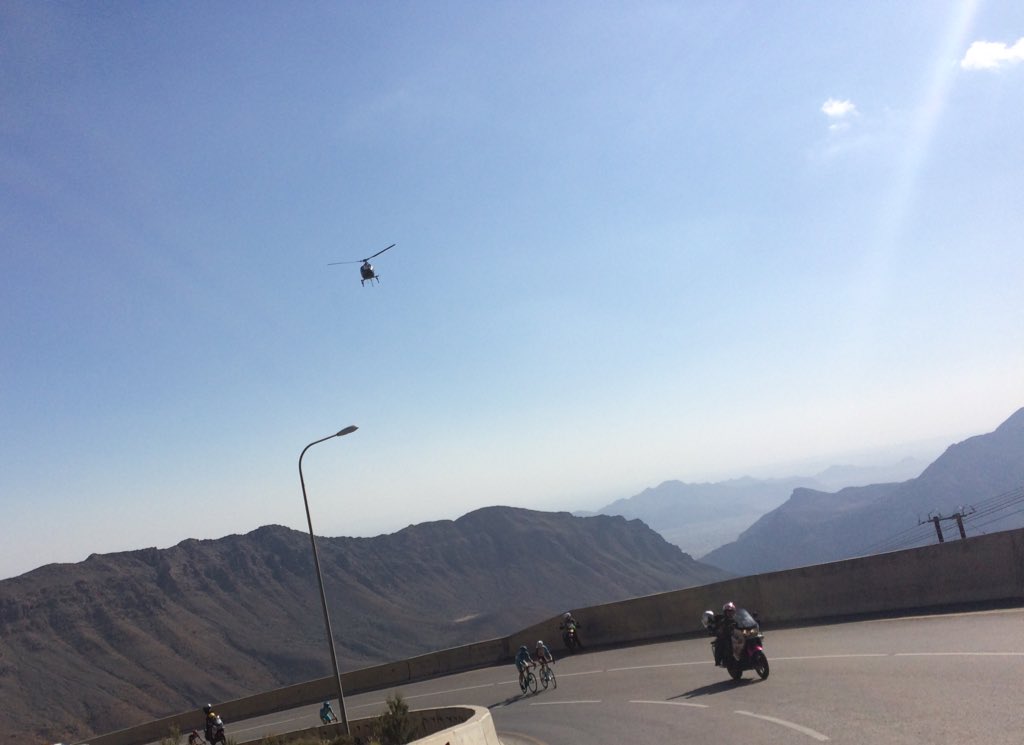Tour of Oman: Nibali lays down a marker on Green Mountain
Italian hitting top form early with his mind on the Giro d'Italia





When Valerio Agnoli reached the top of Green Mountain at the end of stage 4 of the Tour of Oman, a group of journalists had already huddled around the winner Vincenzo Nibali, but he still managed to stretch an arm across the scrum to offer his congratulations to his team leader. “Bravo capo,” Agnoli smiled as he caught Nibali’s eye and then grabbed his hand. Well done, boss.
Astana’s other boss – the big boss, Alexandre Vinokourov – is not in Oman, but though the race is not broadcast live on television, he was kept informed of proceedings in real time. As Nibali finally shed Romain Bardet (AG2R-La Mondiale) on the last ramp before the finish, Vinokourov’s long-term agent, the Belgian Vincent Wathelet, was standing just past the line and he provided the Astana general manager with blow-by-blow commentary over the phone. “Vincenzo’s got it, Vino, he’s won!”
Nibali’s first victory of 2016 had the feel of a mission statement after two years in which he had struggled for form in the early-season. In both 2014 and 2015, Nibali failed to land a win until the Italian Championships in June, but he appears far more advanced in his preparation this time around as he builds towards the Giro d’Italia.
“Obviously in the last two years, with the Tour in mind, I started my season a lot more calmly. But it was always a struggle because inside of me I always had the desire to do more,” Nibali said. “That wasn’t easy. But when you start the season like this, with far more decent condition, it’s more straightforward to go for the win.”
Not that there is anything particularly straightforward about winning atop Jabal Al Akhdar, or Green Mountain as it is known in the English-speaking world. Nibali claimed a significant win here in 2012, a release after his barren 2011 campaign, though the manner of victory was rather different on this occasion.
“Beh, that was a few years ago… In 2012, I took off right from the start of the climb and did it all alone, but this time, it wasn’t the same at all,” he said. “You needed strong nerves to wait all the way until the end. It's different; I was much younger then, with less experience. Now I have more experience under my belt, and a solid team.”
Gearing
The latest race content, interviews, features, reviews and expert buying guides, direct to your inbox!
Nibali’s Astana guard duly laid the groundwork at the foot of Green Mountain, which this time included a brutal sting in the tail in the form of an additional 1.8 kilometres of climbing.
Andriy Grivko, Agnoli and Michele Scarponi led on the lower slopes, before Jakob Fuglsang and Nibali formed a tandem as the gradient stiffened in the finale, though Bardet proved an aggressive foe all the way to the line.
“The extra two kilometres changed how you managed your strength. Even though we won, we made a technical error by using too heavy a gear,” Nibali said. “It was very hard to make a selection because 39x29 was too big on this gradient, so we tried to wait until the final 300 metres and then push it hard.”
The war of attrition up the climb saw Nibali and Bardet as the last men standing, and they remained locked grimly together throughout a brutal final kilometre where the road continued to rise inexorably upwards. Bardet made a final effort in the finishing straight but couldn’t shake Nibali, and with 150 metres to go, the Sicilian inched clear to win by 9 seconds.
Nibali leads Bardet by 15 seconds in the general classification, while his teammate Fuglsang, an impressive third on the stage, is also third overall, 24 seconds back. After feeling his way back into action at the Tour de San Luis last month, Nibali had looked comfortable from the outset in Oman.
“Already in Argentina, I was doing well, just suffering on one or two stages, but here, I'm already reaching some of my best condition ahead my first goal at Tirreno-Adriatico,” Nibali said. “We’ll see. I'll try to finish well here in Oman, recover a bit at home, then think about Tirreno, and then the most important event for me, the Giro.”
The arid slopes of Green Mountain in February are some distance from the mighty summits of the Pordoi or the Agnello in May, but Nibali’s burden for the journey ahead has already been lightened considerably.
“It’s much more straightforward when you know you’re well prepared and you’ve started well,” Nibali said before descending to receive the leader’s red jersey. “It becomes easier to manage your season because you’re not trying to catch up.”

Barry Ryan was Head of Features at Cyclingnews. He has covered professional cycling since 2010, reporting from the Tour de France, Giro d’Italia and events from Argentina to Japan. His writing has appeared in The Independent, Procycling and Cycling Plus. He is the author of The Ascent: Sean Kelly, Stephen Roche and the Rise of Irish Cycling’s Golden Generation, published by Gill Books.